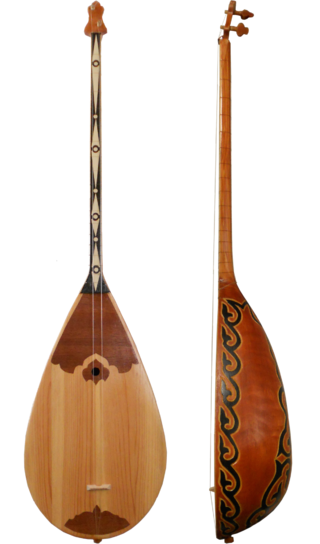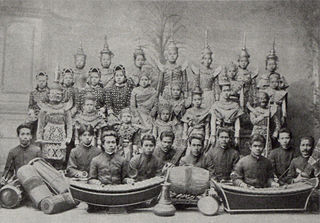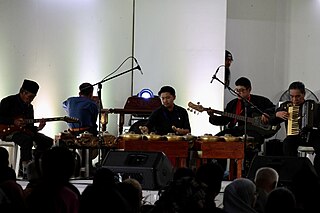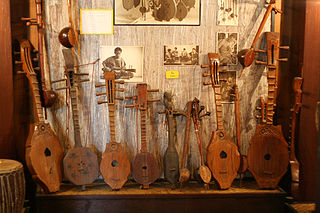
The Subu, Lisu Subu or Sung Lisu is a stringed instrument with a small round body covered in snake skin and a long neck. It has 3 steel strings. It is played in Thailand and Myanmar. [1] [2] [3] [4] [5]

The Subu, Lisu Subu or Sung Lisu is a stringed instrument with a small round body covered in snake skin and a long neck. It has 3 steel strings. It is played in Thailand and Myanmar. [1] [2] [3] [4] [5]

The Dombra, also known as Dombyra or Tambura is a long-necked musical string instrument used by the Kazakhs, Uzbeks, Turkmens, Hazaras, Bashkirs and Nogais in their traditional folk music. The Dombura shares certain characteristics with the komuz and dutar instruments, such as its long, thin neck and oblong body shape. It is a popular instrument mostly among Turkic and Iranic communities in Central Asian countries such as Kazakhstan, Uzbekistan, Tajikistan, Turkmenistan and Afghanistan.

The music of Thailand reflects its geographic position at the intersection of China and India, and reflects trade routes that have historically included Africa, Greece and Rome. Traditional Thai musical instruments are varied and reflect ancient influence from far afield - including the klong thap and khim, the jakhe, the klong jin, and the klong kaek . Though Thailand was never colonized by colonial powers, pop music and other forms of modern Asian, European and American music have become extremely influential. The two most popular styles of traditional Thai music are luk thung and mor lam; the latter in particular has close affinities with the music of Laos.

Brunei is a southeast Asian country located on Borneo between the states of Sabah and Sarawak which are part of Malaysia. There is a wide array of native folk music, and dance. Brunei shares some Cultural perspectives and links with the countries of South East Asia such as Malaysia, Singapore, Indonesia, Thailand, Philippines. The strong Islamic influence means that dance performances and music are somewhat restricted.

Wong khrueang sai is a musical ensemble in Thai classical music which consists primarily of string instruments. A typical khrueang sai ensemble features two two-string fiddles, one high and one low, a three-string zither called jakhe, a vertical duct flute called khlui, hand drums, and various cymbals. Depending on the size of the ensemble, instruments may be doubled or left out. A three-string spike fiddle called saw sam sai may be added as well. The khim has become popular and is also used in this ensemble. In the 20th century, Western instruments such as the violin or organ have also occasionally been integrated into khrueang sai ensembles.

The rebab is the name of several related string instruments that independently spread via Islamic trading routes over much of North Africa, Southeast Asia, the Middle East, and parts of Europe. The instrument is typically bowed, but is sometimes plucked. It is one of the earliest known bowed instruments, named no later than the 8th century, and is the parent of many bowed and stringed instruments.

Wu Man is a Chinese pipa player and composer. Trained in Pudong-style pipa performance at the Central Conservatory of Music in Beijing, she is known for playing in a broad range of musical styles and introducing the pipa and its Chinese heritage into Western genres. She has performed and recorded extensively with Kronos Quartet and Silk Road Ensemble, and has premiered works by Philip Glass, Lou Harrison, Terry Riley, Bright Sheng, Tan Dun, Zhao Jiping, and Zhou Long, among many others. She has recorded and appeared on over 40 albums, five of which have been nominated for Grammy Awards. In 2013, she was named Instrumentalist of the Year by Musical America, becoming the first performer of a non-Western instrument to receive this award. She also received The United States Artists Award in 2008.

Stagg music is a Belgian musical instrument company headquartered in Brussels, currently a subsidiary of EMD Music. The company produce a wide range of musical instruments, which includes string instruments, percussion instruments, tuned metal, free reed and brass instruments as well as effects units and other accessories.

The tro is Cambodia's traditional spike fiddle, a bowed string instrument that is held and played vertically. Spike fiddles have a handle that passes through the resonator, often forming a spike, on the bottom side where it emerges. The family is similar or distantly related to the Chinese erhu or huqin. The instruments have a soundbox at the bottom of the stick, covered with leather or snake skin. Strings run from pegs at the top of the stick and secured at the bottom, running across the soundbox. The larger the soundbox, the lower the pitch range. Instruments in this family include the two-stringed tro ou, tro sau thom, tro sau toch and tro che, as well as the three-stringed tro Khmer spike fiddle. The two-stringed tros are tuned in a fifth, while the three-stringed tro Khmer is tuned in fourths. The tros, with the exception of the tro Khmer, are strung so that the bowstring is permanently placed between the two stings. When the musician plays, the placement of the bow causes the strings to be played at once, one from below and one from above. In contrast, western fiddles are played with the bow pushing on each string from the outside, as is also the case with the tro khmer.

Nanguan is a style of Chinese classical music from the southern Chinese province of Fujian. It is also popular in Taiwan, particularly Lukang on west coast, as well as among Overseas Chinese in Southeast Asia.

Kroncong is the name of a ukulele-like instrument and an Indonesian musical style that typically makes use of the kroncong. A kroncong orchestra or ensemble traditionally consists of a flute, a violin, at least one, but usually a pair of kroncongs, a cello in pizzicato style, string bass in pizzicato style, and a vocalist. Kroncong originated as an adaptation of a Portuguese musical tradition, brought by sailors to Indonesian port cities in the 16th century. By the late 19th century, kroncong reached popular music status throughout the Indonesian archipelago.
Jonas Baes is a Filipino composer. He enrolled in the University of the Philippines' College of Music in 1977 as a student of Ramon P. Santos, and encountered the musical compositions of Jose Maceda, attended several seminar-workshops of visiting lecturers, and did research on the music of the Iraya-Mangyan people of Mindoro, which became the inspiration for his compositions. From 1992 to 1994, he studied with Mathias Spahlinger in Freiburg, Germany. Baes is known for writing music utilizing "unorthodox" musical instruments like bean-pod rattles, leaves, iron-nail chimes, as well as various Asian instruments such as bamboo scrapers, bamboo flutes, and vocal music using Asian vocal techniques. His early works in the 1980s were influenced by Maceda in the use of large numbers of performers, while in the 1990s he experimented with various methods by which the audience becomes integral in the performance. At the beginning of the new century, Baes experiments with notions of structure-agency integration [after Anthony Giddens] and simulacrum [after Jean Baudrillard]. It is typical for social theory to influence the work of Baes who has made a mark on contemporary music and cultural politics in the Asian region. Baes is also active as an ethnomusicologist and writer.

Ching are finger cymbals played in Cambodian and Thai theater and dance ensembles.

The gourd mouth organ is a free reed mouth organ played across East and Southeast Asia. It consists of a gourd wind chest with several bamboo or bronze pipes inserted on top of it, the numbers of pipes differing from region to region.
Traditional Thai musical instruments are the musical instruments used in the traditional and classical music of Thailand. They comprise a wide range of wind, string, and percussion instruments played by both the Thai majority as well as the nation's ethnic minorities.

The sueng is a plucked fretted lute from the northern (Lanna) region of Thailand. The instrument is made from hardwood and its strings are most often made of steel wire. It has nine bamboo frets.

Ranat is the generic name for keyboard percussion instruments used in the music of Thailand. The bars of the various types of ranat may be made from hardwood or bamboo, metal, or, much more rarely, glass.
JFugue is an open source programming library that allows one to program music in the Java programming language without the complexities of MIDI. It was first released in 2002 by David Koelle. Version 2 was released under a proprietary license. Versions 3 and 4 were released under the LGPL-2.1-or-later license. The current version, JFugue 5.0, was released in March 2015, under the Apache-2.0 license. Brian Eubanks has described JFugue as "useful for applications that need a quick and easy way to play music or to generate MIDI files."
The Henschel Quartet is a German string quartet comprising the Henschel siblings; Christoph and Markus (violinists), Monika (viola) and Mathias Beyer-Karlshøj (cellist), who joined them in 1994. Brother Markus left the quartet in 2010, and was succeeded by Daniel Bell in 2012. In 2016–2018 Catalin Desaga took the place of the second violin. Today the Quartet consists of following members: Christoph Henschel and Teresa La Cour (violinists), Monika Henschel (viola) and Mathias Beyer-Karlshøj (cello).

The tube zither is a stringed musical instrument in which a tube functions both as an instrument's neck and its soundbox. As the neck, it holds strings taut and allows them to vibrate. As a soundbox, it modifies the sound and transfers it to the open air. The instruments are among the oldest of chordophones, being "a very early stage" in the development of chordophones, and predate some of the oldest chordophones, such as the Chinese Se, zithers built on a tube split in half. Most tube zithers are made of bamboo, played today in Madagascar, India, Southeast Asia and Taiwan. Tube zithers made from other materials have been found in Europe and the United States, made from materials such as cornstalks and cactus.